Solar Eclipse Data Reveal Surprising Conclusion
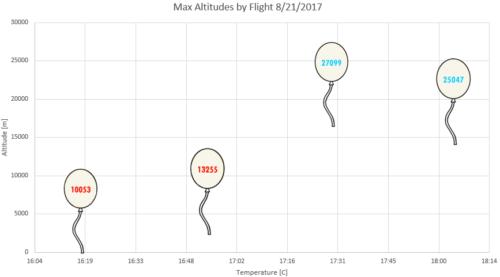
This graph when the weather balloons popped that were launched during the eclipse. Red text: terminated prematurely; blue text: full flight.
The conference room in the LaSells Stewart Center at Oregon State University was full of enterprising scientists and engineers that had gathered by invitation of the Oregon NASA Space Grant Consortium (OSGC). Presentations that day ranged from creating antiviral drugs using silver nanoparticles to designing spin stabilizing systems for microsatellites. The topic of one presentation in the afternoon, however, was one that nearly everyone there had personal experience with: the August 21 total solar eclipse.
It was during this presentation that a trio of researchers told the story of releasing high-altitude weather sensors during the solar eclipse to measure atmospheric changes, one of only a few research groups to ever attempt such a feat. After the presentation, they regained their seats, relieved to have completed their first-ever professional talk. These researchers were not NASA scientists nor professional researchers – rather, they were students from Oregon Coast Community College. In fact, all presentations that day were given by college students that had traveled to Corvallis from various corners of the state.
The solar eclipse research group was comprised of Nina Cox, Savannah Grey, and Daniel Folkerts, and they were the first OCCC students to present at the annual OSGC Student Research Symposium, held this year on November 9. They began the project at the start of the summer after responding to an ad for a summer internship.
“I organized this project because I want students to engage in the process of science, partake in the thrill of discovery, and to develop the skills that will help them succeed in future endeavors,” said Matthew Fisher, science faculty at OCCC.
Fisher and top brass at OCCC helped these students receive thousands of dollars of financial support from OSGC for the equipment needed to release specialized weather sensors, called radiosondes, high into the atmosphere using large, helium-filled balloons. The radiosondes captured atmospheric data and transmitted it in real time to students using radiowave transmissions. Earlier in the summer, OSGC also provided students with financial support to travel to the University of Montana to train in preparation for the Aug. 21 event.
“I was very excited to visit Montana in July, as it was not only my first time on a plane but we also got to meet other students who would be conducting the same research,” said Grey, a second-year student.
On the day of the solar eclipse, students launched four radiosondes at regular intervals during the eclipse: two before totality and two after totality. The weather balloons carrying the radiosondes reached altitudes ranging from 10 km (6.2 miles) to 27 km (16.8 miles).
Students collected and analyzed several thousand data points. Highlighting the collaborative and transparent nature of science, students shared their data with researchers across the US for further exploration and scrutiny into the atmospheric effects of solar eclipses.
“This project gave me the rare opportunity to gain experience in collecting and analyzing data very early on in my academic career,” said Grey, who plans to finish her degree at OCCC and then to transfer to Oregon State University to study oceanography and marine science.
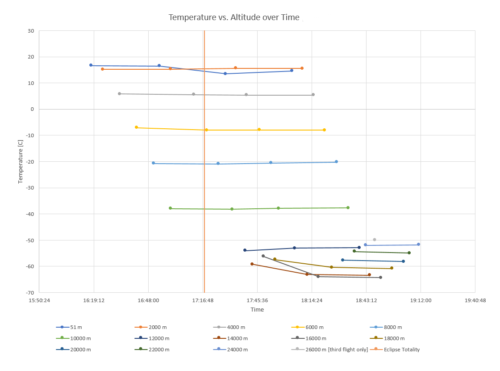
This chart shows temperature readings every 2000 meters over time during the solar eclipse. Each dot represents a temperature reading at a particular altitude, with different altitudes indicated by color. The time of totality is indicated by a vertical orange line.
Students found that the solar eclipse had little impact on atmospheric variables such as temperature, relative humidity, and wind speed and direction, which was surprising because the sun provides the energy that drives climate. While people that witnessed the eclipse in person felt a rapid cooling of air temperatures at ground level, students found that the temperatures changes did not occur at higher altitudes, even those as low as 1,000 meters. Thus, the cooling effect was isolated to very low altitudes.
The project was rich in learning opportunities that will prepare students for future success, regardless of their major. For example, students learned how to work in a team, analyze data, produce graphs, and develop effective oral and written communication skills.
“This project is a great example of engaging students in the kind of scholarly activities that make them competitive when applying to four-year institutions and pursuing scholarships, internships, and jobs,” said Fisher.
SOAR Blog Entry #3
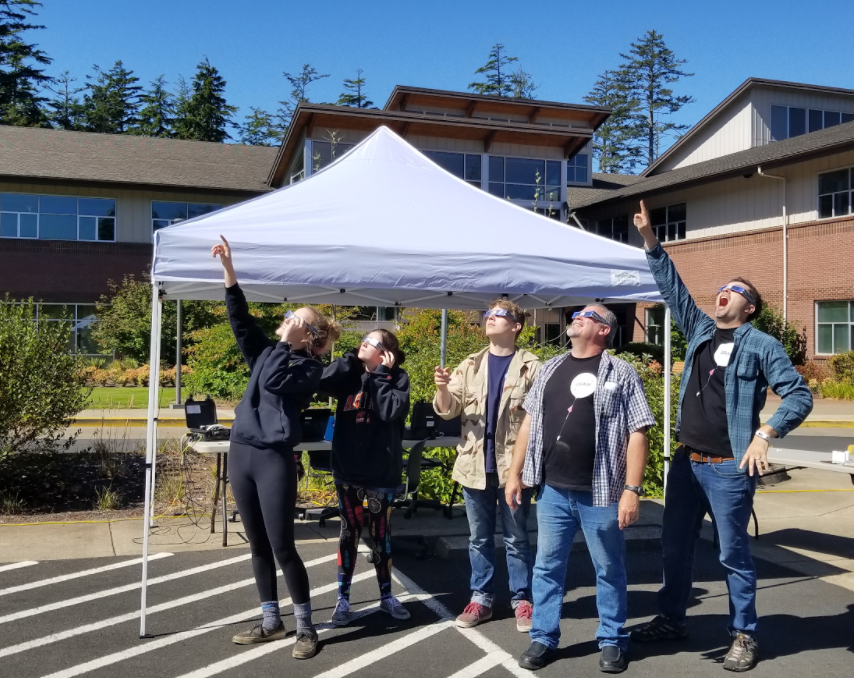
The SOAR team, from left, Nina Cox, Savanna Grey, Daniel Folkerts, Donnie Duncan, and a very excited Matthew Fisher.
Mission accomplished! Four balloons launched during #TSE2017
NEWPORT – Aug. 28, 2017
My name is Nina Cox and I am writing the third field report for SOAR’s eclipse mission. Our team had two months to prepare for our task: sending up multiple weather balloons during the Aug. 21 total solar eclipse. I can gladly report-that the SOAR team easily pulled it together and successfully launched four balloons during the eclipse! We were one of several teams across the country to do this. Most other teams had months or a year of experience, when we had very little.
A quick recap: before the eclipse we traveled to the University of Montana to learn how to launch balloons with a radiosonde (weather sensor) attached. After that, we conducted multiple trial launches at the OCCC campus to work out the kinks. Without those previous launches, I doubt our team could have undergone such a smooth and successful day during the eclipse.
During the weekend of the eclipse we were hosting students and faculty from San Jose State University (SJSU) and Linn Benton Community College (LBCC) at OCCC, as they also planned to collect data with weather balloons and radiosondes. SJSU released their radiosondes from OCCC’s campus (as did we), while LBCC ventured 50 miles out on a boat. Donnie Duncan, a SOAR member, graciously volunteered to host these teams during their stay over the eclipse weekend.
The day of the eclipse finally arrived and the pressure was definitely on! Reports indicated that over one million people were expected to visit Oregon, and many of those visitors were to make their way to the coast. Everyone was very much prepared for this mass of people to accumulate, but in shock, they never arrived. Everyone in Newport was thoroughly confused, but it turns out the forecast that called for 72% cloud cover scared them all away. Thus, the mass fled east in hopes of guaranteed sun. In disbelief, the morning of the eclipse was nothing but fog. However, as the morning grew into the afternoon the clouds disappeared and blue skies revealed itself just in time for the eclipse! Everyone was thoroughly pleased with blue skies and no overcrowding from tourists.
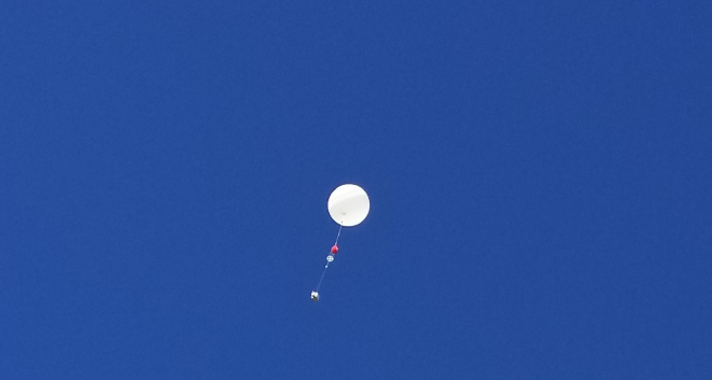
A successful launch: sending up a radiosonde with clear skies during the eclipse.
The SOAR team met at 7:30 a.m at OCCC on Aug. 21 to start prepping for the eclipse. We needed to make sure everything was intact, that the checklist was checked three times over, and that everyone knew what their job was. We also needed to ensure that the frequencies of our radiosondes would not interfere with SJSU’s. Because we had four weather balloon launches in a duration of two hours, the team needed to have leaders and assigned jobs so everything could be done in an orderly matter. Savannah Grey was in charge of team one and Daniel Folkerts was in charge of team two. I was in charge of balloon fill and the handheld weather meter which takes necessary data for initialization. Donnie was in charge of contacting the Coast Guard, Newport airport, and was the balloon fill manager, which insures that everything is being done correctly.
Once everything was in order, team one started initializing the radiosonde and began balloon fill. At 9:18 am we released our first balloon, which was just minutes after the partial eclipse begun. Everyone was extremely excited as the moon started to engulf the sun. It was hard to just not stop and stare, but we had to continue our project. Because we had multiple launches in a short amount of time, we needed to terminate our first two launches early in order to begin initialization of our third and fourth radiosondes. We only had two computers and each computer could only take data from one radiosonde at a time. After 45 minutes our first launch was terminated and our second radiosonde was launched at 9:54 am. Two very successful launches had been done before totality, and now we could sit back for a little and watch the magic happen in the sky!
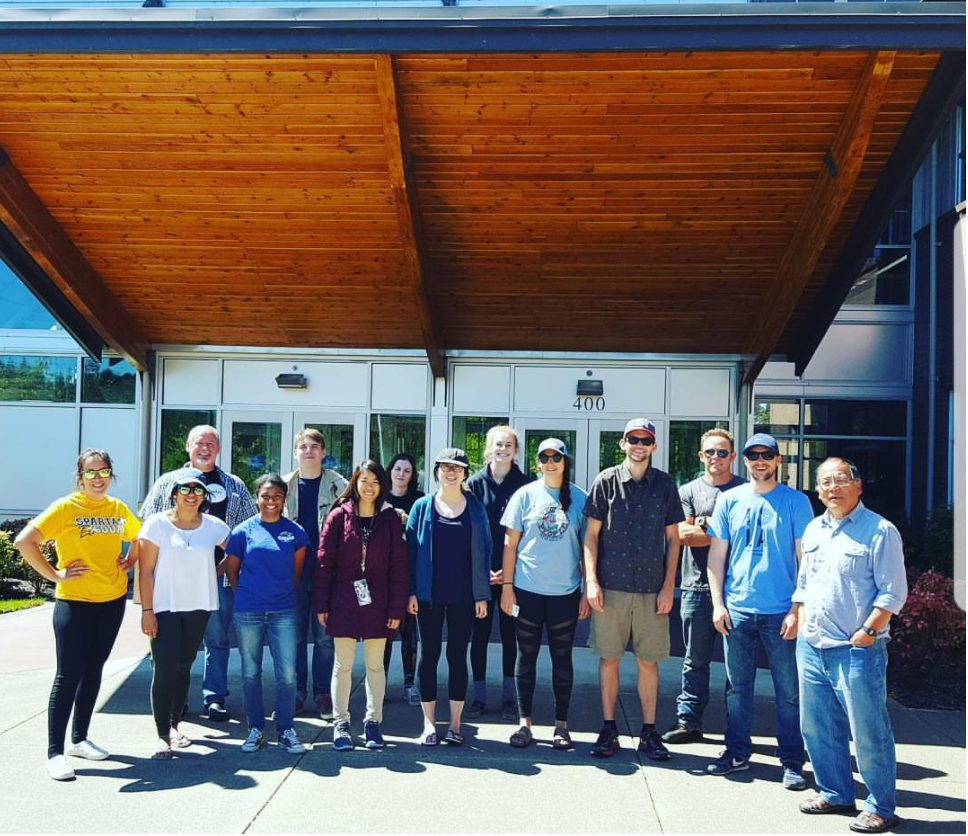
The San Jose State University and OCCC SOAR teams pose outside the main entrance to OCCC.
Totality began at 10:15 am and the environment around us started to noticeably change as the moon crossed over the sun. It started to get noticeably colder by the second, the morning started to turn into the night as stars began to appear, the birds began to go insane, which means totality had finally arrived. It was a sight that cannot be explained by words. It was mesmerizing, breathtaking, and it easily made everyone speechless. It was truly a sight that should’ve not been missed!
After totality, the SOAR team still had two more launches to do. We quickly got our act back together and conducted two more successful launches. The third one being launched at 10:29 am and the fourth to be launched at 11:04. Because we had no more launches after these, they did not require early termination and could run through their whole course. As part of SOAR tradition, we took bets at what altitude the balloons would pop, and we then sat back, relaxed, and reflected on our data and how our launches went. I am thoroughly proud of the SOAR team because everyone played an important role and we were truly a team with this project!
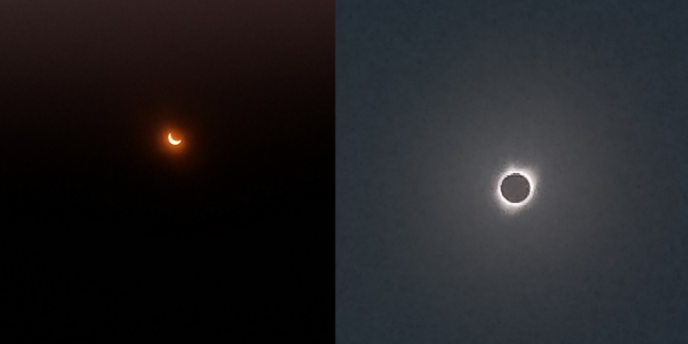
Partial eclipse and totality.
SOAR Blog Entry #2
SOAR team readies for eclipse with
second test launch
NEWPORT – Aug. 16, 2017
My name is Savannah Grey and I’m writing the second field report for OCCC’s SOAR team, documenting our progress since our visit to Montana and leading up to the Aug. 21 solar eclipse. Equipped with the knowledge gained during our visit to the University of Montana and one practice launch here in Oregon, we are confident that we now possess the skills to launch successfully on the day of the eclipse.
In the weeks leading up to the eclipse, we planned five practice launches at OCCC’s Newport campus. The first launch took place on August 7th, over a week after our Montana visit and a full two weeks before the eclipse. We started by laying out our new helium tank, which was donated by Industrial Welding Supply (IWS). Without this helium our launches wouldn’t be possible, thank you IWS! The rest of our equipment was fresh out of the plastic wrappings, foam casings, and packing peanuts they were shipped in. It all arrived shortly after our return from Montana, so it took us all a moment to familiarize ourselves and get our bearings, but we were able to jump right into routine.
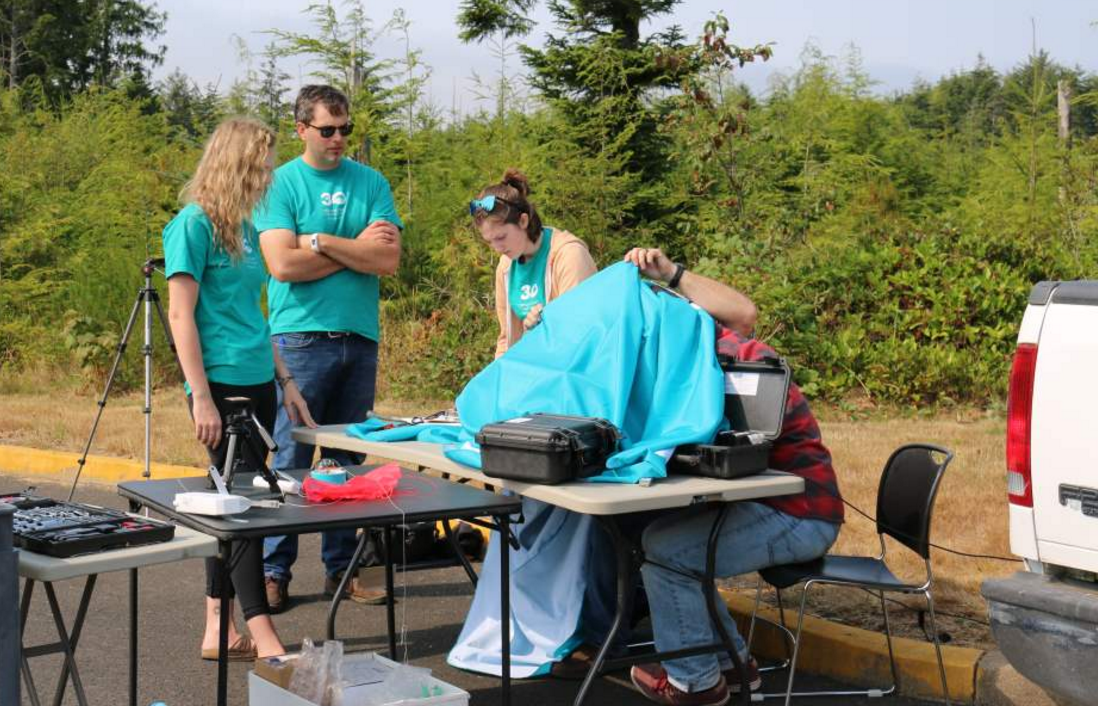
While other team members stand by, Donnie Duncan and Daniel Folkerts huddle under a tablecloth to escape the sun’s glare on our laptop during initialization of the radiosonde
Tarp ready for filling the balloon, fold-out tables spread with tools, and laptop charging via Donnie Duncan’s truck, we had everything prepped and ready to go for the actual launch. However, we had some difficulties initializing our radiosonde, the key component to our launch. During the initialization process, we are not only connecting our radiosonde to our receiver to create a line of communication between us and the sky, we are also making sure that the radiosonde itself is trustworthy. To guide us through the process we were constantly referencing the SOP (Standard Operating Procedure) manual written by University of Montana’s Deb Ross and Jen Fowler, which walks us through the sometimes frustrating initialization process. Despite the help of the SOP we were still having problems connecting the radiosonde, but we kept our cool and were determined to find a solution and get something in the air that day.
After trying to initialize the radiosonde for the better part of an hour, we made the decision to try using a different radiosonde and… success! We all felt relieved to have successfully initialized a radiosonde, but we still needed to make sure that we were getting accurate data from the radiosonde before preparing the balloon itself. We had to let the radiosonde acclimate for three to ten minutes, which meant that we had to compare the ground values (pressure, temperature, relative humidity, wind speed, etc.) interpreted by the radiosonde was close enough to our Kestrel. A Kestrel is a lightweight, handheld weather meter that we use as a control against the data coming in from our weather sensor. After we determined the radiosonde data was within normal range, we hurried over to the grass to begin filling the balloon.
After filling the balloon with helium, testing it for it capabilities to lift our payload (radiosonde), and securing the train (consisting of the parachute, dereeler, and radiosonde) to the balloon, we were finally able to set it off into the air. That day the radiosonde reached roughly 27 kilometers (16 miles), but sadly I didn’t save the data correctly. Fortunately, this was a practice launch. Our next two launches the following Sunday and Monday, however, went smoothly and without any hiccups. We even got to save our data!
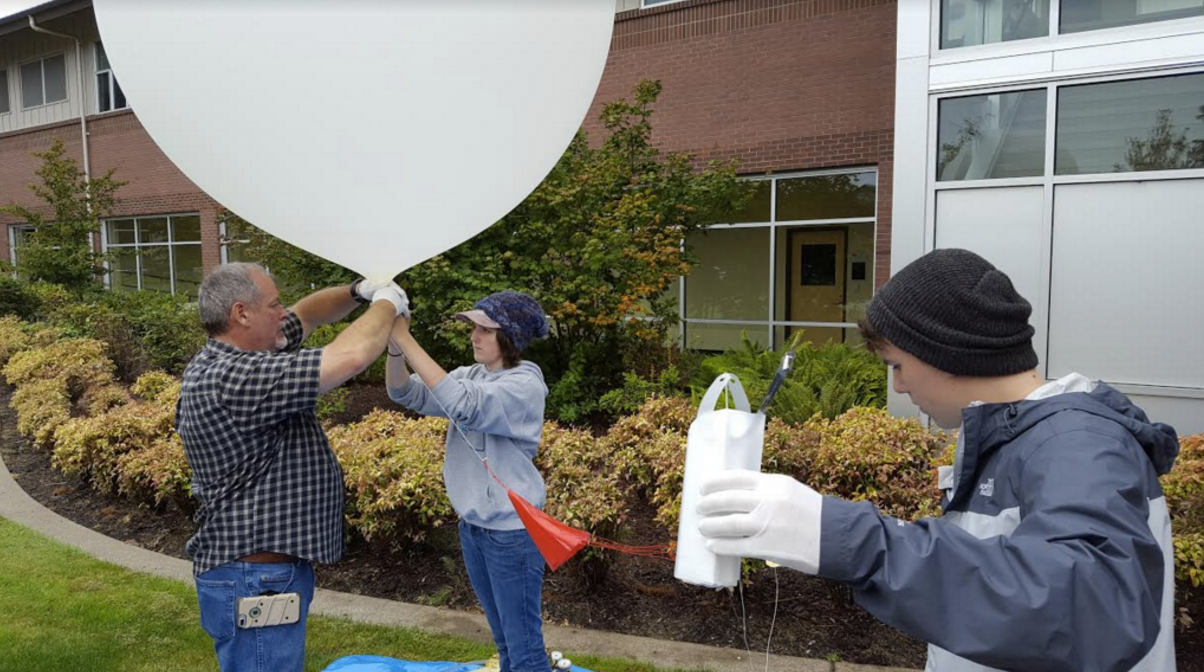
Donnie, me, and Daniel attaching the train to the balloon during Sunday’s launch – we reached about 22 km (13 miles) in altitude that day.
The SOAR team has also been busy making arrangements for our guests and designing a team logo. During the eclipse weekend, there will be two other teams staying on OCCC’s campus, one from Linn-Benton Community College (LBCC) and the other from San Jose State University (SJSU), who both plan on conducting their own balloon launches during the eclipse. The LBCC students will launch a balloon to livestream video of the total eclipse online, the first group to do so in the country. The SJSU students, meanwhile, lead by post-doctorate Jiashu Song and researcher AJ Eiserloh, will be working alongside us to gather atmospheric data.
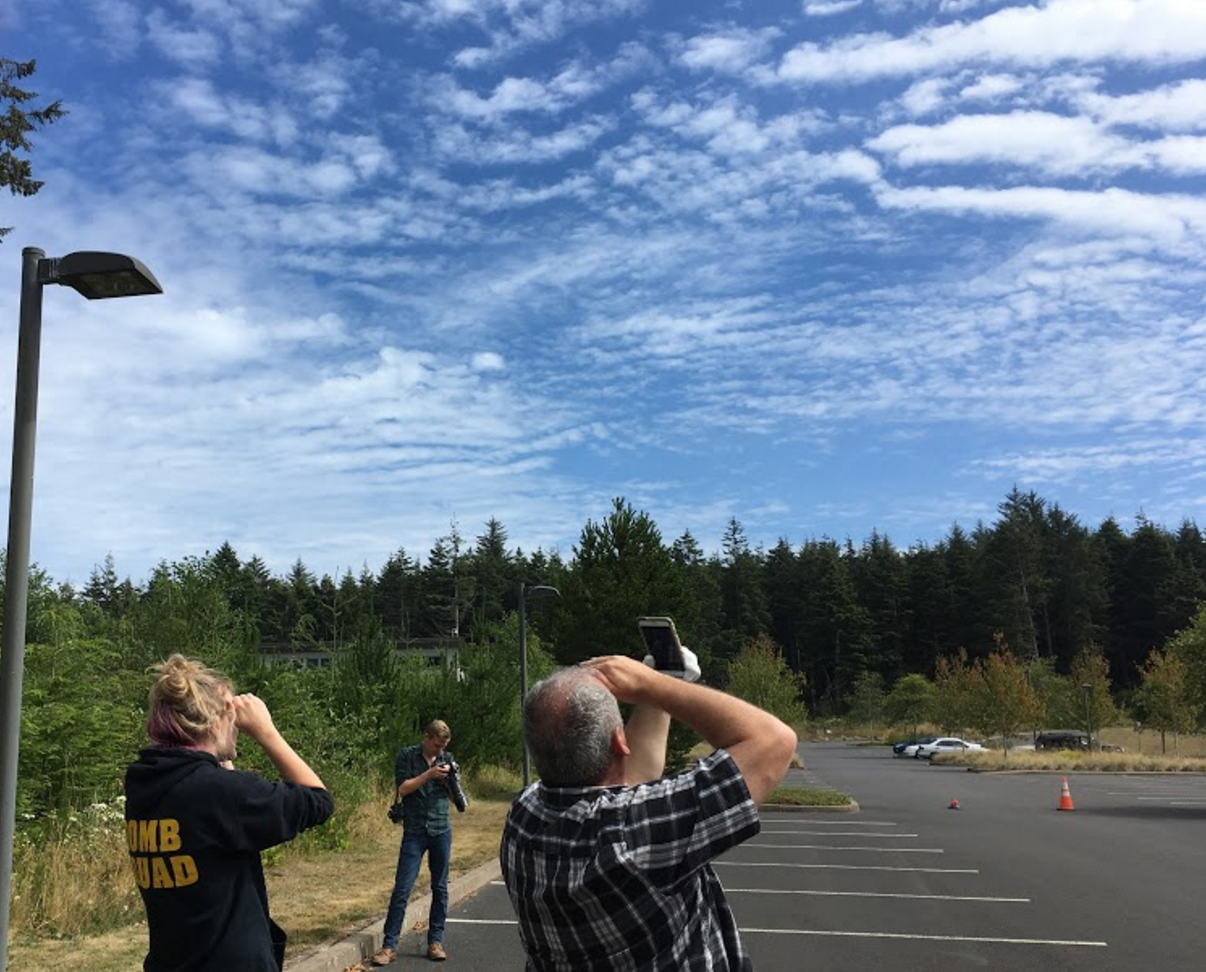
Nina Cox and Donnie watching the balloon take flight on our third practice launch, the day we broke our personal record by reaching a maximum altitude of 28.3 km (17 miles)!
We have also recently developed a logo for SOAR. As a team, we discussed what everyone would like to see in the logo, with Nina Cox and myself being the artists behind the drafts. We wished to highlight not only meteorological and atmospheric components, but also personalize it towards Oregon. The final draft of the logo shows the image of a helium-filled balloon carrying a radiosonde, backed by the curvature of the Pacific Northwest (a star marking Newport’s location), and the hint of the yellow-orange glow of the upper atmosphere. The logo is not only meant to represent our current team but also future teams after our summer project ends. We hope that SOAR will continue to be lead by students other than ourselves, as most of us plan on transferring to four-year universities after next year.
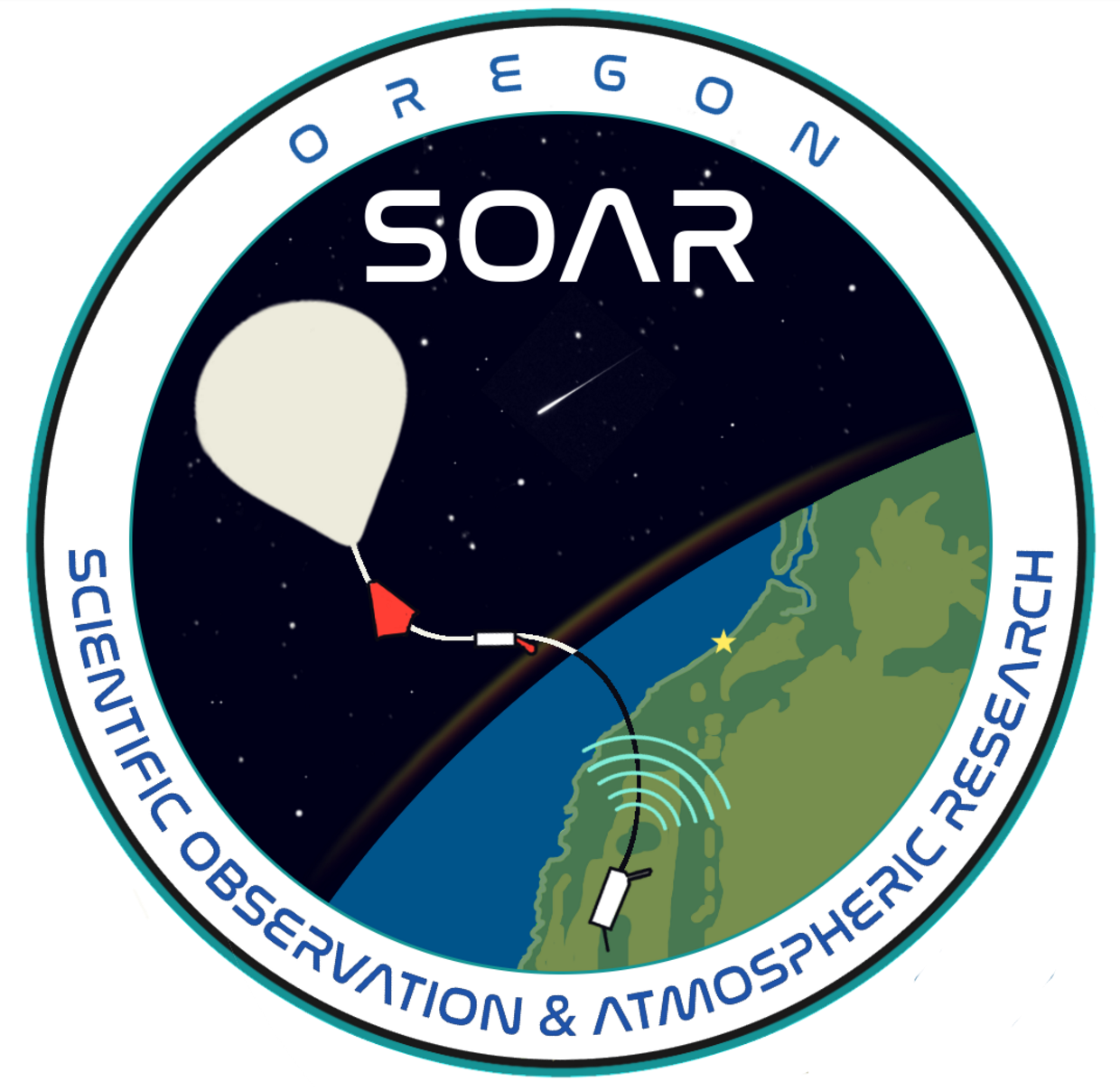
Nina and I collaborated on a logo design for SOAR, which I digitized in this final version.
SOAR Blog Entry #1
OCCC students launch new program
with a launch
SOAR Students travel to Montana
My name is Daniel Folkerts and I’m writing the first of four field reports for OCCC’s SOAR (Scientific Observation & Atmospheric Research) team. We endeavor to launch weather balloons on August 21st, 2017 to collect atmospheric data during a total solar eclipse! The SOAR team consists of students from OCCC and includes myself, Donnie Duncan, Savannah Grey, Nina Cox, and team leader Matthew Fisher, an OCCC science instructor.
This first log documents our recent three-day work trip taken to Missoula to receive training from a student team located at the University of Montana (UM). At this point in time our team was only 3 weeks old and we had taken a crash course on atmospheric science to prepare for the more advanced training we’d receive at UM. When we arrived at the University we were greeted by a group of people about 5 times the size of our team. The UM students, which were mostly juniors and seniors studying physics and computer science, introduced themselves and gave a synopsis of their personal role in the project. The leader of the project on both a regional and national level is Jen Fowler, who works for both the UM and the Montana Space Grant Consortium.
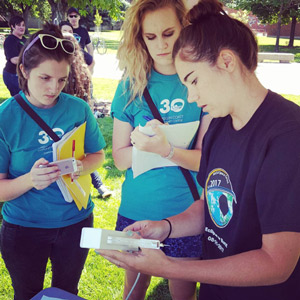
SOAR team members Nina and Savannah watch as a UM student shows how to initialize a radiosonde.
After the introductions, we began an overview of both radiosondes and the project to document the eclipse. Radiosondes are devices that hang from weather balloons and collect atmospheric data, such as temperature and humidity, and then send those data back to the surface using radio waves. Next, we were shown how to operate the equipment needed to conduct a successful weather balloon launch.
Soon we went outside in the hot Montana sun and began an actual balloon launch. The UM team led the way while we observed and learned. They made a great effort to incorporate us into the launch so that we could get involved and learn from it. The first step was to set up two laptop computers and initialize the radiosonde to them (in the event that one laptop stops receiving data, the other acts as a backup so no data are lost). Next, they began to fill a large latex balloon with enough helium so it would rise at a rate higher than 5 m/s, but not become so over-inflated that it would prematurely pop. The balloon and radiosonde were released and quickly rose into the air. We watched as the live data began to appear on both computers. The balloon popped at about 18,000 meters (11 miles) up and then parachuted down. The balloons are designed to be able to reach 33,000 meters maximum, so 18,000 was a little more than half.
On the second day our team was taught more advanced atmospheric science and given an in-depth look into skew-T plots (a complicated graph favored by meteorologists). The real pièce de résistance was our own balloon launch. This launch was conducted entirely by the Oregon SOAR team, with little outside help to make sure that we had learned the process. SOAR team members Savannah and Nina learned the software the day before, so they took the role of inputting the per-launch data and initializing the radiosonde. I took the role of reading the weather meter and attaching the radiosonde to the rest of the “train.” The train is the entire set of strings, dereeler, and parachute that connects the balloon to the radiosonde.
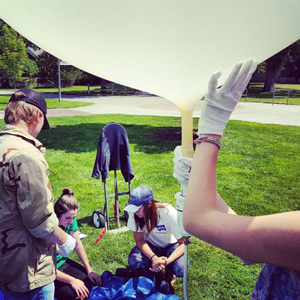
Nina holds the balloon as it fills with helium. Savannah and I monitor the helium tank regulator, along with a UM student.
Once we had all completed our steps, we began to fill the balloon with helium the same way we had seen the UM team do the day before. We attached the radiosonde to the balloon and watched as the balloon flew, but the radiosonde did not! The string I tied came apart with the sudden jerk of the rising balloon. We quickly repeated our steps in order to save the battery life on the radiosonde, and successfully launched on the second attempt. The next hour and a half was spent monitoring the data as it came pouring in. This process took far longer than the day before because the balloon we launched achieved a height of 26,000 meters (16 miles)! That launch concluded our second day, which left the third day for various fun activities such as a planetarium viewing and floating the Clark Fork River that runs through the middle of Missoula. We wish to extend our thanks to Oregon NASA Space Grant Consortium for travel support.
Learn more about SOAR on Facebook, or contact OCCC’s Matthew Fisher via email.
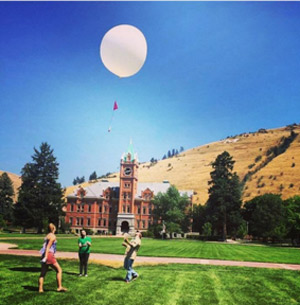
Nina, Savannah, and I successfully launch our first weather balloon. University Hall is visible in the background.

